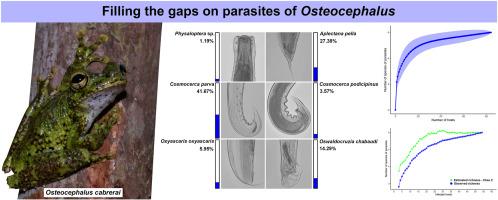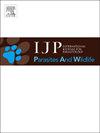填补Osteocephalus寄生虫方面的空白:巴西亚马逊河流域Osteocephalus cabrerai(Anura: Hylidae)的螺旋虫群落结构
IF 2
3区 医学
Q3 ECOLOGY
International Journal for Parasitology-Parasites and Wildlife
Pub Date : 2024-09-19
DOI:10.1016/j.ijppaw.2024.100996
引用次数: 0
摘要
Osteocephalus cabrerai 是一种广泛分布于南美洲的树栖无尾类动物。然而,目前还没有针对该物种的寄生虫学研究,因此寄生虫动物群落完全不为人知。因此,本研究旨在描述巴西亚马逊地区阿马帕州 Pedra Branca do Amapari 市的 O. cabrerai 寄生虫群落结构。我们收集并解剖了 84 个 O. cabrerai 标本,以寻找蠕虫。我们利用螺旋寄生虫的丰富度、多样性和丰度分析了寄生虫群落结构。O. cabrerai的蠕虫群落由六种线虫组成:Cosmocerca parva、Cosmocerca podicipinus、Oxyascaris oxyascaris、Oswaldocruzia chabaudi 和 Physaloptera sp.(幼虫)。宿主体内的蠕虫感染呈现出典型的寄生虫聚集分布模式。我们只发现宿主体重与总感染强度呈正相关。我们对参考文献的修订加强了对Osteocephalus属蠕虫动物群进一步研究的必要性。本文章由计算机程序翻译,如有差异,请以英文原文为准。

Filling the gaps on parasites of Osteocephalus: Helminth community structure of Osteocephalus cabrerai (Anura: Hylidae) from the Brazilian Amazon
Osteocephalus cabrerai is an arboreal anuran widely distributed in South America. However, there are no parasitological studies conducted on the species, resulting in a parasite fauna completely unknown. Thus, this study aims to characterize the parasitic community structure of O. cabrerai in the municipality of Pedra Branca do Amapari, Amapá state, Amazon region, Brazil. We collected and necropsied 84 specimens of O. cabrerai to search for helminths. Parasite community structure was analyzed using helminth parasite richness, diversity, and abundance. The helminth component community of O. cabrerai comprises six nematode species: Cosmocerca parva, Cosmocerca podicipinus, Oxyascaris oxyascaris, Oswaldocruzia chabaudi, and Physaloptera sp. (larvae). Most helminth species represent the first record for the genus Osteocephalus, except Physaloptera sp. The helminth infections in the host showed a typical aggregated distribution pattern for parasites. We only found a positive correlation between the host weight and total intensity. Our bibliography revision reinforces the need for further studies on the helminth fauna of Osteocephalus spp.
求助全文
通过发布文献求助,成功后即可免费获取论文全文。
去求助
来源期刊

International Journal for Parasitology-Parasites and Wildlife
Medicine-Infectious Diseases
CiteScore
3.80
自引率
5.60%
发文量
113
审稿时长
45 days
期刊介绍:
The International Journal for Parasitology: Parasites and Wildlife (IJP-PAW) publishes the results of original research on parasites of all wildlife, invertebrate and vertebrate. This includes free-ranging, wild populations, as well as captive wildlife, semi-domesticated species (e.g. reindeer) and farmed populations of recently domesticated or wild-captured species (e.g. cultured fishes). Articles on all aspects of wildlife parasitology are welcomed including taxonomy, biodiversity and distribution, ecology and epidemiology, population biology and host-parasite relationships. The impact of parasites on the health and conservation of wildlife is seen as an important area covered by the journal especially the potential role of environmental factors, for example climate. Also important to the journal is ''one health'' and the nature of interactions between wildlife, people and domestic animals, including disease emergence and zoonoses.
 求助内容:
求助内容: 应助结果提醒方式:
应助结果提醒方式:


